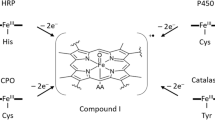Abstract
Resonance Raman studies have uncovered puzzling complexities in the structures of NO adducts of heme proteins. Although CO adducts of heme proteins obey well-behaved anti-correlations between Fe–C and C–O stretching frequencies, which reflect changes in backbonding induced by distal H-bonding residues, the corresponding NO data are scattered. This scatter can be traced to distal influences, since protein-free NO–hemes do show well-behaved anti-correlations. Why do distal effects produce irregularities in νFeN/νNO plots but not in νFeC/νCO plots? We show via density functional theory (DFT) computations on model systems that the response to distal H-bonding differs markedly when the NO acceptor atom is N versus O. Backbonding is augmented by H-bonding to O, but the effect of H-bonding to N is to weaken both N–O and N–Fe bonds. The resulting downward deviation from the νFeN/νNO backbonding line increases with increasing H-bond strength. This effect explains the deviations observed for a series of myoglobin variants, in which the strength of distal H-bonding is modulated by distal pocket residue substitutions. Most of the data follow a positive νFeN/νNO correlation with the same slope as that calculated for H-bonding to N. Such deviations are not observed for CO adducts, because the CO π* orbital is unoccupied, and serves as a delocalized acceptor of H-bonds. H-bonding to N primes NO–heme for reduction to the HNO adduct, a putative intermediate in NO-reducing enzymes.







Similar content being viewed by others
Abbreviations
- DFT:
-
Density functional theory
- EPR:
-
Electron paramagnetic spectroscopy
- ImH:
-
Imidazole
- Mb:
-
Myoglobin
- NMeIm:
-
N-Methylimidazole
- NRVS:
-
Nuclear resonance vibrational spectroscopy
- P:
-
Porphine
- RR:
-
Resonance Raman
- TPP:
-
Tetraphenylporphine
- XAFS:
-
X-ray absorption fine-structure
References
Spiro TG, Wasbotten IH (2005) J Inorg Biochem 99:34–44
Park ES, Boxer SG (2002) J Phys Chem B 106:5800–5806
Ibrahim M, Xu CL, Spiro TG (2006) J Am Chem Soc 128:16834–16845
Coyle CM, Vogel KM, Rush TS, Kozlowski PM, Williams R, Spiro TG, Dou Y, Ikeda-Saito M, Olson JS, Zgierski MZ (2003) Biochemistry 42:4896–4903
Lin R, Farmer PJ (2000) J Am Chem Soc 122:2393–2394
Sulc F, Immoos CE, Pervitsky D, Farmer PJ (2004) J Am Chem Soc 126:1096–1101
Immoos CE, Sulc F, Farmer PJ, Czarnecki K, Bocian DF, Levina A, Aitken JB, Armstrong RS, Lay PA (2005) J Am Chem Soc 127:814–815
Frisch MJ et al. (2003) Gaussian 03. Gaussian, Inc., Pittsburgh, PA
Bauernschmitt R, Ahlrichs R (1996) Chem Phys Lett 256:454–464
Praneeth VKK, Nather C, Peters G, Lehnert N (2006) Inorg Chem 45:2795–2811
Tangen E, Svadberg A, Ghosh A (2005) Inorg Chem 44:7802–7805
Zhang Y, Gossman W, Oldfield E (2003) J Am Chem Soc 125:16387–16396
Patchkovskii S, Ziegler T (2000) J Am Chem Soc 122:3506–3516
Zeng WQ, Silvernail NJ, Wharton DC, Georgiev GY, Leu BM, Scheidt WR, Zhao JY, Sturhahn W, Alp EE, Sage JT (2005) J Am Chem Soc 127:11200–11201
Badger RM (1935) J Chem Phys 3:710–714
Green MT (2006) J Am Chem Soc 128:1902–1906
Linder DP, Rodgers KR (2005) Inorg Chem 44:8259–8264
Lai HH, Li TS, Lyons DS, Phillips GN, Olson JS, Gibson QH (1995) Proteins 22:322–339
Karow DS, Pan DH, Tran R, Pellicena P, Presley A, Mathies RA, Marletta MA (2004) Biochemistry 43:10203–10211
Pellicena P, Karow DS, Boon EM, Marletta MA, Kuriyan J (2004) Proc Natl Acad Sci USA 101:12854–12859
Das TK, Wilson EK, Cutruzzola F, Brunori M, Rousseau DL (2001) Biochemistry 40:10774–10781
Nurizzo D, Cutruzzola F, Arese M, Bourgeois D, Brunori M, Cambillau C, Tegoni M (1998) Biochemistry 37:13987–13996
Nioche P, Berka V, Vipond J, Minton N, Tsai AL, Raman CS (2004) Science 306:1550–1553
Ghosh A (2005) Acc Chem Res 38:943–954
Franzen S (2002) J Am Chem Soc 124:13271–13281
Copeland DM, West AH, Richter-Addo GB (2003) Proteins 53:182–192
Copeland DM, SoareS AS, West AH, Richter-Addo GB (2006) J Inorg Biochem 100:1413–1425
Brucker EA, Olson JS, Ikeda-Saito M, Phillips GN (1998) Proteins 30:352–356
Rich AM, Armstrong RS, Ellis PJ, Lay PA (1998) J Am Chem Soc 120:10827–10836
Sono M, Roach MP, Coulter ED, Dawson JH (1996) Chem Rev 96:2841–2887
Paolocci N, Katori T, Champion HC, St John ME, Miranda KM, Fukuto JM, Wink DA, Kass DA (2003) Proc Natl Acad Sci USA 100:5537–5542
Miranda KM (2005) Coord Chem Rev 249:433–455
Farmer PJ, Sulc F (2005) J Inorg Biochem 99:166–184
Rusche KM, Spiering MM, Marletta MA (1998) Biochemistry 37:15503–15512
Einsle O, Messerschmidt A, Huber R, Kroneck PMH, Neese F (2002) J Am Chem Soc 124:11737–11745
Averill BA (1996) Chem Rev 96:2951–2964
Sulc F, Fleischer E, Farmer PJ, Ma DJ, La Mar GN (2003) J Biol Inorg Chem 8:348–352
Kachalova GS, Popov AN, Bartunik HD (1999) Science 284:473–476
Vojtechovsky J, Chu K, Berendzen J, Sweet RM, Schlichting I (1999) Biophys J 77:2153–2174
Linder DP, Rodgers KR, Banister J, Wyllie GRA, Ellison MK, Scheidt WR (2004) J Am Chem Soc 126:14136–14148
Walker FA (2005) J Inorg Biochem 99:216–236
Acknowledgments
This work was supported by NIH grant GM 33576 from the National Institute of General Medical Sciences. We thank Dr. Mohammed Ibrahim for helpful discussions and for assistance in preparing the manuscript.
Author information
Authors and Affiliations
Corresponding author
Rights and permissions
About this article
Cite this article
Xu, C., Spiro, T.G. Ambidentate H-bonding by heme-bound NO: structural and spectral effects of –O versus –N H-bonding. J Biol Inorg Chem 13, 613–621 (2008). https://doi.org/10.1007/s00775-008-0349-8
Received:
Accepted:
Published:
Issue Date:
DOI: https://doi.org/10.1007/s00775-008-0349-8




